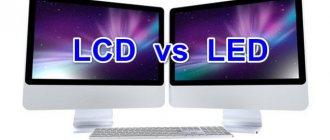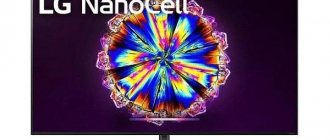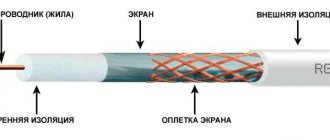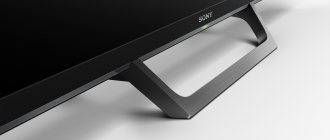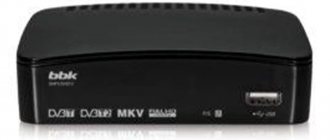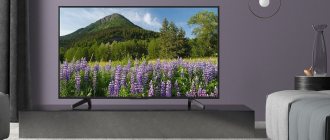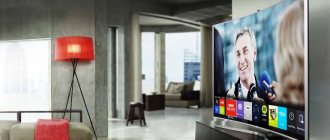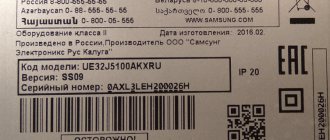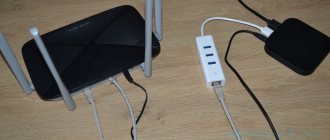Capsule coffee Nescafe Dolce Gusto Cappuccino, 3 packs of 16 capsules
1305 ₽ More details
Coffee capsules Nescafe Dolce Gusto Cappuccino, 8 servings (16 capsules)
435 ₽ More details
OPPO A5 smartphones
VA and IPS are not new technologies. They appeared in 1996. For some, it may seem like there is no difference between the two. Despite their long existence, VPS and IPS still compete and have their fans. It is quite difficult to identify a leader in terms of functionality.
VA matrix
VA is a matrix, the main part of which is vertical alignment technology. It arose instead of the well-known TN. In their normal state, liquid crystals have a perpendicular alignment.
General information
The VA matrix appeared 24 years ago. It was first manufactured by Fujitsu. It was they who came up with a new technology for manufacturing liquid crystal matrices. The crystals in them are arranged perpendicularly. In the traditional position, polarized light passes through the liquid crystals without problems.
During its existence, the matrix, of course, has been improved. Thanks to this, there are now several variations of it. The newer version can be considered MVA. Over time, PVA products also appeared. They were manufactured by Samsung. Each type has its own characteristics:
- MVA. Technology has replaced VA. This option is better than the first version in every way. Almost all existing shortcomings were eliminated over time. The MBA's response rate has decreased significantly. The accuracy of color reproduction has increased. They became several times more saturated. The black color has become deeper and better quality. Viewing angles in the MBA have increased to 160-180 degrees. Only in difficult situations do small details disappear from certain angles.
- PVA. This is a unique development from Samsung. The main advantages include excellent contrast and low cost. In this form, viewing angles are significantly improved. The shades of black are rich and deep. The only drawback is the distortion of some colors.
These are the main types of VA.
Manufacturing technology
The principle of vertical alignment is used in manufacturing. Liquid crystals are arranged perpendicularly. It is in this position that the rays pass without difficulty.
The second polarizer blocks the passage of light. Thanks to this, color contrast appears. Modern products use new multi-domain structure technology. Each cell has several crystals. Technology takes the picture to a new level.
Pros and cons of VA matrices
The matrix has its own advantages and disadvantages. Positive properties include short reaction time, wide viewing angles, and a high level of contrast.
The disadvantages include not as good color rendering as we would like. Additionally, some small details in complex scenes disappear from a certain viewing angle, but this drawback cannot be considered critical.
IPS matrix
The IPS matrix was created in 1995, but was first released only in 1996. Liquid crystals are located in the same plane. They are parallel to the plane of the panel. Thanks to this, viewing angles have been increased.
General information
The IPS monitor is ideal for setting up a home theater. They are often chosen by people who work with design and photography.
Over the entire period of its existence, the matrix has been modernized several times. The following subspecies are distinguished:
- S-IPS, which has significantly reduced response time;
- AS-IPS, which is characterized by increased brightness and contrast;
- H-IPS, which has increased realism;
- P-IPS, which is one of the most popular matrices in the world;
- E-IPS, which is more budget-friendly;
- AH-IPS, which included all the most necessary improvements from other models.
The matrix has LED and fluorescent backlighting. It is better to choose models with LED backlighting. They are considered more modern.
Manufacturing technology
The main feature is that in IPS displays the crystals rotate simultaneously. For this reason, there are wide viewing angles. You can even look at such a screen at an angle of 180 degrees.
During manufacturing, filters are placed perpendicular to each other. Thanks to the unique technology of creating the picture, it is as realistic as possible.
Pros and cons of IPS matrices
The first and one of the main advantages is low cost. Pixel burn-in is virtually eliminated. Even after many years of use, the picture does not lose its richness.
Another significant advantage is high image quality. On the latest models you can watch videos in the highest quality. It is believed that IPS models have the best viewing angles.
Not without its shortcomings. The matrix has a response time higher than that of VA.
Diagonal
Monitor size is important, but don't go overboard. Firstly, the larger the display, the more expensive it is. Secondly, the larger it is, the higher the resolution and, accordingly, the higher the load on the processor and video card. However, if you have a powerful video card and the price is not a problem, then you can easily get a 30-inch monitor.
A small screen is also not an option: working behind it will not be very convenient. The best option for comfortable work is a monitor with a diagonal of 24-27 inches with a screen resolution from 1920x1080 pixels to 4K. Naturally, the larger the diagonal, the higher the resolution should be.
Differences between VA and IPS matrices
When choosing a matrix, buyers usually compare the main characteristics. VA and IPS do not have significant differences, but nevertheless they are present. The main indicators are presented in the table.
| Index | VPS | IPS |
| Black color and contrast | In this case, the UPS is certainly in the lead. Thanks to the unique design, the pixels transmit less light. Any picture looks contrasting and rich. | On IPS, blacks are less saturated. On cheap models it may even turn gray. |
| Viewing angle | At a large angle, the contrast is greatly reduced. This can be a huge disadvantage when using the monitor in a large room. Additionally, the wider the screen, the greater the angle of the rays from its outer parts. The latter problem has recently begun to be addressed thanks to the curvature of the screen. | The matrix is popular precisely because of its large viewing angle. |
| Glow effect | In VPS, the glow effect also occurs, but much less frequently. | The glow effect is the unevenness of the screen backlight. This problem is more common with IPS screens. The unevenness of illumination in a dark room is especially pronounced. On high-quality new models the effect is minimized. |
Thanks to the table, you can understand that both types of matrices have both their advantages and disadvantages. When purchasing, it is better to focus on the purpose for which the screen will be used.
Backlight uniformity
For comfortable work and correct post-processing, the relative uniformity of the illumination is important. To ensure that the screen is illuminated evenly, a diffuser glass is placed between the LEDs and the matrix. If it is not uniform enough, then large bright or dark spots may be visible on the working screen.
In addition, the uniformity of illumination is affected by how accurately the distances between the diodes, the diffuser glass and the matrix are maintained. Because of this, even monitors from the same batch have different backlight uniformity. That is why it is very important to turn on the monitor when purchasing and check how evenly the screen is illuminated.
Visual comparison of VA and IPS matrices
Which matrix is better - VA or IPS
The screen with a matrix can only be used for work or, for example, for watching movies. It is on these goals that you need to rely when selecting the most suitable device.
For TV
IPS technology is often used in the manufacture of TVs. This is due to the large viewing angle. The TV can be viewed from any part of the room, with virtually no loss in picture quality. You need to choose just such a device if there is a need for a large viewing angle.
If the picture is more important to the user and he plans to watch TV without moving around the room, then it is better to choose VA. It is this matrix that is characterized by deep elaboration of colors. The picture responds faster and turns out as realistic as possible. The problem of poor viewing angles can be solved by purchasing a curved screen. In this case, an additional feeling of presence appears when watching films.
For monitor
The monitor can be used for games and work:
- For games. If the buyer likes to play dynamic games, then you need to pay attention to the response time. This is the speed of response to user actions. The VA monitor has the best response time. IPS matrix is not suitable for dynamic games. But it gives a delightful picture and perfectly conveys colors. This matrix is best chosen by fans of quiet games that focus on well-developed graphics and plot. In this case, low response speed does not play a special role. You can give preference to modern curved models. This will give you the opportunity to immerse yourself in the atmosphere of the game as much as possible. Players of dynamic games should also pay attention to hertz. The higher it is, the more spectacular the game will be. The image will be smooth and realistic.
- For work. IPS monitors are ideal for work. The high contrast of the matrix is combined with large viewing angles. If there is a need for a large screen, then it is advisable to choose curved monitors with right angles.
Both matrices find application and have fans.
Backlight type
Speaking about the types of matrices and color gamut, it is necessary to mention the backlight. The pixels themselves on the matrices do not light up, so monitors use different types of backlights.
Previously, cold cathode lamps (CCFLs), which are similar to the fluorescent lamps we are used to, were used to illuminate matrices. The main disadvantage of such lighting is its fragility. The phosphor in lamps quickly loses its properties and the lamps degrade until they completely lose the blue part of the spectrum. Nowadays, CCFL-backlit monitors are no longer produced, but they can still be found on the secondary market.
Modern monitors have LED backlighting, which also varies. Its most common type is W-LED, i.e. White LED. Despite the word White, the LEDs in this backlight are not white, but blue. The light they emit is passed through yellow phosphorus, which produces a white glow. This type of backlight is cheaper than others and, at the same time, allows you to get a color gamut very close to 100% of the sRGB space. Such illumination also has disadvantages, and the main one is a pronounced bluish tint (which, by the way, tires the eyes and negatively affects our health). And the cheaper the matrix, the more noticeable this drawback will be.
In order to expand the color gamut, manufacturers began to use RGB-LED backlighting, which contains LEDs of three primary colors: red, green and blue. The color gamut of such monitors almost reaches Adobe RGB. However, different colors of LEDs degrade at different rates, and monitors deteriorate almost as quickly as older lamp-backlit monitors.
A solution to this problem was GB-LED backlighting. It contains green and blue LEDs, the light of which is passed through a red phosphor. Such illumination is in no way inferior to RGB-LED in terms of color gamut width, but noticeably surpasses it in durability and energy efficiency. If you know for sure that you will work with an expanded color gamut, then you should choose a monitor with a GB-LED backlight.
The best monitors
When choosing a monitor, you can also pay attention to ratings. Only the highest quality models are included in them. Below are the best monitors, according to buyers. They are distributed in descending order by demand and number of positive reviews.
Top 5 monitors with IPS matrix
This matrix is ideal for work and non-dynamic games. There are both cheaper and more expensive models. The second option is preferable. Cheap options can flicker a lot.
LG 25UM58 25″
LG 25UM58 25″ is equipped with a 21:9 wide screen. The screen is equipped with a wide viewing angle, so its use will help you 100% immerse yourself in the atmosphere of what is happening on the monitor.
Among the preset modes for use there is a “Game” mode. Switching is carried out as quickly as possible.
The screen has a built-in black stabilization feature. Thanks to this, you can make the picture brighter and juicier. The black color becomes several times deeper. Dynamic Action Sync technology makes the picture on the screen more dynamic, realistic and exciting. Any response delays are minimized.
This model minimizes color loss. Thanks to this, the screen can be used to work with photos and videos. Menu settings are carried out using a convenient on-screen menu. An additional advantage is the ultra-thin design.
LG 29UM69G 29″
This monitor is mainly aimed at gamers. The image distortion at the edges is slight. The main feature of this monitor is the presence of a leg, thanks to which you can adjust the angle of inclination. Unfortunately, the screen height cannot be changed.
The monitor can be easily rotated in the other direction due to the fact that only 1 support is non-slip. The body is completely glossy. The edges are rounded. All connectors on the device are horizontal.
A distinctive feature of the device is the presence of a video mode. You can set settings focused on shooters or strategy. It is possible to customize the brightness, contrast and other video parameters.
The maximum screen refresh rate is 75 Hz. There is no flickering on this model even at the lowest brightness. The monitor has a matte finish. The glossiness is practically not visible.
Backlight uniformity is average. The glow effect is average. Under certain viewing angles, a purple or blue coating appears. The highlights are not pronounced. The advantages include good picture quality on the monitor. The disadvantages include the average uniformity of illumination.
DELL P2418D 23.8″
The DELL P2418D 23.8″ monitor has improved performance. This is a great device for multitasking. This monitor is one of the budget ones. However, it is in no way inferior to more expensive options.
The image remains clear at any viewing angle. The decrease in brightness is slight. You can place multiple application windows on the screen at the same time. The response time of the monitor is 5 ms.
You can change the angle of the monitor. The stand of the device is functional. Viewing angles are large, both vertical and horizontal. In the settings there are only 2 options for overclocking the matrix - normal and fast.
Iiyama ProLite XUB2792QSU-1 27″
Iiyama monitors are not common. Many users are afraid to take a device because the company is not popular and in vain. On computer forums, the Iiyama ProLite XUB2792QSU-1 27″ is extremely positive.
The aspect ratio of the Iiyama ProLite XUB2792QSU-1 27″ is 16:9. The matrix is capable of reproducing more than 1 million color shades. The picture on the monitor turns out juicy and contrasty.
AOC Q3279VWFD8 31.5″
Model AOC Q3279VWFD8 31.5″ guarantees excellent color depth and contrast. The picture on the monitor is well detailed. No detail will be missed.
AOC Q3279VWFD8 31.5″ can be used not only for watching movies, but also for games. AMD's FreeSync technology eliminates input lag. The picture is high quality regardless of the viewing angle.
Image flicker is reduced, so using the monitor will not cause eye pain. The monitor refresh rate is 75 Hz.
Top 5 monitors with VA matrix
Monitors with VA matrix are an ideal option for gamers who prefer dynamic games. The device is also suitable for film buffs.
Samsung C24F390FHI 23.5″
When using the Samsung C24F390FHI 23.5″, a wide field of view is created. This makes the screen seem many times larger than it actually is. The monitor itself is curved so that when viewing the extreme points there is no feeling of strain in the eyes, and working or playing behind the monitor is comfortable.
If necessary, you can change the angle of the screen. Even with the strongest tilt, the picture quality does not deteriorate.
For players, there is a game mode on the monitor. It turns on by pressing one button, which is extremely convenient. Game mode makes it possible to optimize the image and make blacks deeper.
The monitor has a built-in function to protect the eyes from the negative effects of flicker and overvoltage.
Samsung C27JG50QQI 26.9″
Samsung C27JG50QQI 26.9″ – a wide workspace with a high-quality picture. You can view multiple web pages at the same time without scrolling. Thanks to the slight curvature, you can work at the monitor without feeling eye fatigue. Due to their unique shape, they do not overexert themselves.
The contrast is 3000:1. White and black and all its shades are best displayed. The screen aspect ratio is 16 to 9. The image refresh rate is 144 Hz.
AOC C24G1 24″
The 25-inch gaming monitor is in the mid-price category. The model has a curved display with a radius of curvature of 1500R. The refresh rate is high at 144 Hz. The response time is 4ms, which is good for a gaming monitor. The picture is bright and contrasting.
BenQ EW277HDR 27″
BenQ EW277HDR 27″ is an improved version of older monitors. The body remains the same, but the insides have changed and become several times better. This is a budget monitor that is unrivaled in its price range.
The matrix coating is semi-matte. The response time is 4 ms, which puts the model on par with more expensive options. The screen does not flicker during prolonged use, which is a significant advantage.
Xiaomi Mi Surface Display 34″
Another best monitor is Xiaomi Mi Surface Display 34″. It has an aspect ratio of 21:9. There is no backlight flickering. Matrix overclocking is adjustable. The surface of the monitor is anti-glare.
The design of the monitor is strict. There are no unnecessary details that distract attention. The uniformity of the screen curvature of the model is good.
Screen surface
There are three display surface options: glossy, matte and semi-matte. Glossy monitors provide a brighter picture, richer color reproduction and good contrast (that is, they reproduce blacks better). The downside of a glossy surface is its reflective ability. On the screen, as in a mirror, all objects are reflected, including ourselves and light sources - lamps, sun rays, etc., which greatly interferes with work and creates additional strain on the eyes.
Matte screens slightly mute colors and reduce contrast, but they provide a clear picture without harsh glare. Another disadvantage of a matte surface is the “crystalline” effect. True, not all people can notice it.
The compromise is a semi-matte (or semi-gloss) finish. It provides better contrast and color rendition than a matte surface, and does not create glare inherent in a glossy surface. And the semi-gloss surface does not have a “crystalline” effect.
The best TVs
You need to take a responsible approach to choosing a TV. Such a device is more expensive, so not everyone will be able to replace a TV when needed.
The rating is based on customer reviews. As with monitors, they are ranked in descending order of popularity.
Top 5 TVs With IPS Matrix
The main feature of such TVs is the operation of the crystals in the same plane between the substrate and the polarizer. The picture is displayed stably at any angle.
| Model | Main characteristics |
| LG 55UM7300 55″ (2019) | LG 55UM7300 55″ (2019) – a device with voice control. The image on the device has increased clarity. The detail is high and the colors are vibrant, making the picture more vibrant. The TV has a wide viewing angle. That is why you can watch it from any angle without losing quality. Colors are displayed with almost 100% accuracy. It is maintained even at an angle of 60%. The processor is fast quad-core. Thanks to this, there is no extraneous noise. The processor also provides more dynamic color reproduction. Low-resolution pictures on your TV are upscaled and enhanced. Even the slightest difference in shades can be easily noticed on the screen. |
| LG 43UM7450 43″ (2019) | This is a 4K TV. Like the model above, it is equipped with artificial intelligence and voice control. The processor has 4 cores. The TV has wide viewing angles. Thanks to this, even from the farthest corner of the room you can see the image on the TV. At the same time, the colors practically do not change regardless of the viewing angle. |
| NanoCell LG 49SM9000 49″ (2019) | This is one of the best premium TVs. Its screen format is 16:9. The main advantage of this model can be considered a 120 Hz frequency. The disadvantages include the lack of black depth, which is typical for all IPS matrices. The TV's unique built-in technology improves color purity. |
| Samsung UE43RU7400U 43″ (2019) | This is a budget model of the company. The design of the TV is discreet. Its assembly is at a good level. Response time is 20ms. Moving objects on the screen leave behind a small trail. The model is equipped with voice control. |
| Sony KD-49XF7596 48.5″ (2018) | This model is already difficult to find on sale. This is its main drawback. The advantages of the device include a refresh rate of 50 Hz. Like the new models, there is voice control. |
You need to understand that all of the listed models have one important drawback. Black shades are dull. This is why the experience of watching films that are too dark can be ruined.
Top 5 TVs with VA matrix
In such TVs, colors are more saturated and contrasty. However, the viewing angle suffers. The best models with a VA matrix are described in the table.
| Model | Characteristic |
| LG 50UM7300 50″ (2019) | The TV has a simple design. There are thin metallic edges. The model has an expanded color range, which is a significant advantage. There is a cursor on the remote control, which at a certain point is a very convenient tool. The LG 50UM7300 50″ (2019) has a good viewing angle, but in complex scenes small details may disappear. |
| LG 60UM7100 60″ (2019) | LG 60UM7100 60″ (2019) is equipped with a 4-core processor. The device has artificial intelligence and the ability to control by voice. Color rendering is dynamic and contrasting. The TV reproduces color shades as accurately as possible. Thanks to this, the picture turns out to be as detailed and realistic as possible. |
| SkyLine 40LT5900 40″ (2019) | This is a high-quality LCD TV with LED backlight. The device plays even the highest quality videos. The refresh rate is 50Hz, which is average. |
| Polarline 40PL51TC 40″ (2018) | Polarline 40PL51TC 40″ (2018) – TV equipped with LED backlighting. The screen aspect ratio is 16 to 9. The refresh rate is 50 Hz. |
| Sony KD-55XG9505 54.5″ (2019) | This is a mid-range TV. Equipped with voice control. The picture is high quality with deep blacks. There is a local dimming function. Excellent gradient handling is present. Dynamic scenes are reproduced perfectly. The delay time is up to 21 ms. |
VA and IPS matrices have their own advantages and disadvantages. When choosing, it is better to consider exactly how the device will be used.


